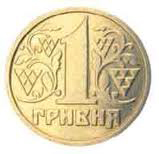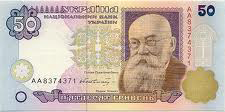|


The hryvnia, sometimes hryvnya (Ukrainian: гривня, pronounced [ˈɦrɪu̯nʲɑ]); sign: ₴, code: (UAH), has been the national currency of Ukraine since September 2, 1996. The hryvnia is subdivided into 100 kopiyok.
Name
Etymology
The currency of Kievan Rus' in the eleventh century was called grivna. The word is thought to derive from the Slavic griva; c.f. Ukrainian, Russian, Bulgarian and Serbian грива / griva, meaning "mane". It may have indicated something valuable worn around the neck, usually made of silver or gold; c.f. Bulgarian and Serbian grivna (гривна, "bracelet"). Later, the word was used to describe silver or gold ingots of a certain weight; c.f. Ukrainian hryvenyk (гривеник), Russian grivennik (гривенник, "10-kopek piece"). Other smaller currency units were nogata (ногата, pelt of a large animal such as a bear or а wolf), kuna (куна, pelt of a small animal such as a mink or а sable; c.f. Croatian kuna). The smallest unit was veksha (векша, squirrel pelt).
The modern Ukrainian hryvnia is sometimes transliterated as hryvna, hrivna, gryvna or grivna, due to its Russian language counterpart, гри́вна, pronounced grívna. However, the standard English name for the currency is hryvnia.
The National Bank of Ukraine has recommended that a distinction be made between hryvnia and grívna in both historical and practical means.
Plural
The nominative plural of hryvnia is hryvni (Ukrainian: гривні). This is also the genitive singular of hryvnia, while the genitive plural is hryven′ (Ukrainian: гривень). In Ukrainian, the genitive singular form is used for numbers ending with 2, 3, or 4, as in dvi hryvni (дві гривні, "2 hryvni"), and the genitive plural is used for numbers ending with 5 to 9 and 0, for example sto hryven’ (сто гривень, "100 hryven’"); for numbers ending with 1 the nominative singular form is used, for example dvadtsiat' odna hryvnia (двадцять одна гривня, "21 hryvnia"). The singular for the subdivision is копійка (kopiyka), the nominative plural is копійки (kopiyky) and the genitive is копійок (kopiyok).
History
A currency called hryvna was used in Kievan Rus'. In 1917, after the Ukrainian National Republic declared independence from the Russian Empire, the name of the new Ukrainian currency became hryvnia, a revised version of the Kievan Rus' hryvna. The designer was Heorhiy Narbut.
The hryvnia replaced the karbovanets during the period September 2–16, 1996, at a rate of 1 hryvnia = 100,000 karbovantsiv. The karbovanets was subject to hyperinflation in the early 1990s following the collapse of the USSR.
To a large extent, the introduction of hryvnia was secretive. Hryvnia was introduced according to President's Decree dated August 26, 1996, published on August 29. During the transition period, September 2–16, both hryvnia and karbovanets were used in circulation, but merchants were required to give change only in hryvnias. All bank accounts were converted to hryvnia automatically. During the transition period, 97% of karbovanets were taken out of circulation, including 56% in the first 5 days of the currency reform. After September 16, 1996, the remaining karbovanets were allowed to be exchanged to hryvnias in banks.
The hryvnia was introduced during the period when Victor Yushchenko was the Chairman of National Bank of Ukraine. However, the first banknotes issued bore the signature of the previous National Bank Chairman, Vadym Hetman, who had resigned back in 1993. This was so because the first notes had been printed as early as 1992 by the Canadian Bank Note Company, but it had been decided to delay their circulation until the hyperinflation in Ukraine was brought under control.
Initially, the foreign exchange rate was UAH 1.76 = USD 1.00. Following the Asian financial crisis in 1998 the currency devaluated to UAH 5.6 = USD 1.00 in February 2000. Later, the exchange rate remained relatively stable at around 5.4 hryvnias for 1 US dollar and was fixed to 5.05 hryvnias for 1 US dollar from 21 April 2005 until 21 May 2008. In mid-October 2008 rapid devaluation began with the hryvnia dropping 38.4 % from UAH 4.85 for USD 1 on 23 September 2008 to UAH 7.88 for USD 1 on 19 December 2008.
Coins
Coins were first struck in 1992 for the new currency but were not introduced until 1996. The coins were initially produced by Luhansk Cartridge Factory., as well as by Italian Mint. In addition to those listed below which were released into circulation, 15 kopiyok coins were struck in both brass and aluminium.
Banknotes
In 1996, the first series of hryvnia banknotes was introduced into circulation by the National Bank of Ukraine. They were dated 1992 and were in denominations of 1, 2, 5, 10 and 20 hryven’. The design of the banknotes was developed by Ukrainian artists Vasyl Lopata and Borys Maksymov. One hryvnya banknotes were printed by the Canadian Bank Note Company in 1992. Two, five and ten hryvnya banknotes were printed two years later. Until introduction into circulation the banknotes were kept in Canada.
Banknotes of the first series in denominations of 50 and 100 hryven' also existed but due to some reasons they were never introduced.
Also in 1996, the 1, 50, and 100 hryvnia notes of the second series were introduced, with 1 hryvnia dated 1994. The banknotes were designed and printed by British De La Rue. Since the opening of the Mint of the National Bank of Ukraine in cooperation with De La Rue in March 1994 all banknotes have been printed in Ukraine.
Later, highest denominations were added. The 200 hryvnia notes of the second series were introduced in 2001, followed by the 500 hryvnia notes of the third series in 2006.
All hryvnia banknotes issued by the National Bank continue to be a legal tender. As of 2008, the banknotes of early series can rarely be found in circulation.
Exchange rates
Official NBU exchange rate at moment of introduction UAH 1.76/USD 1.
In the period from 21 April 2005 through 21 October 2008 the official exchange rate remained stable at around UAH 5/USD 1. Since then, the hryvnia abruptly lost one-third of its value, dropping to around UAH 7.5/USD 1 by mid-December 2008. The hryvnia remained relatively stable through most of the first half of 2009, being valued at roughly 7.5-8 UAH/USD 1 over this period. However, the hryvnia began a gradual depreciation in the 3rd quarter of 2009 to reach just under 9 UAH/USD by September, although this was followed by a quick appreciation to around 8.25 UAH/USD by the start of October. Through the 4th quarter of 2009 and the start of 2010, the value of the hryvnia has held relatively steady at approximately 8.0-8.25 UAH/USD.
The text on this page has been made available under the Creative Commons Attribution-ShareAlike License and Creative Commons Licenses
| 